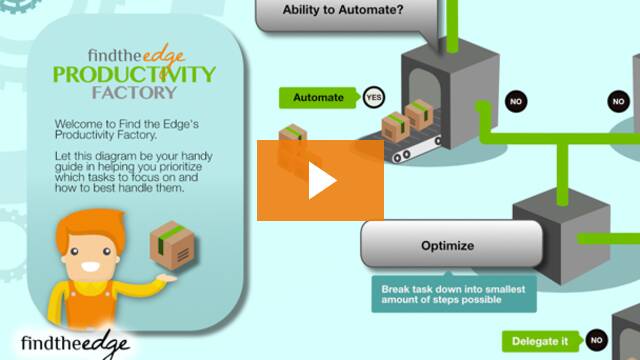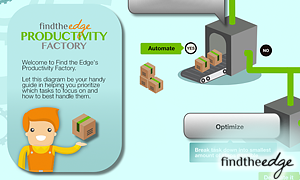Podcast: Play in new window | Download | Subscribe on iTunes
Share this Image On Your Site, Copy the Embed Code Below
Let’s just go back to, is it a recurring task as well, because if it’s a recurring task, then I ask myself at that point, do I have the ability to automate it? That’s either a yes or a no. if yes, then I automate it using various different tools. We might build our own tools in house or we might use lots of great tools like Zapier or If This Then That, which are tools that help various applications speak to each other so that you can automate tasks.
So I can give you a very quick example of that. I don’t do this anymore because I use Xero as my accounting tool. But I used to have lots of invoices, receipts, all of that kind of stuff coming into my inbox, into my Gmail. What I did is I used If This Then That to create what they call a recipe and basically, If This Then That spoke between Gmail and Evernote.
So if invoices, receipts or anything that had that kind of word ‘orders’ or anything in the subject line, that came into Gmail, it would automatically save to an Invoices folder within my Evernote. My bookkeeper would have access to that as well.
So instead of me going in and getting all of these invoices, which is a manual task, I was able to automate it so that my bookkeeper could have access to all of this. We’ve gone one step further now and we’ve got Xero and that does everything a lot better for us.
So can you automate it? Yes, automate it; no, then if it’s not a quick task and if it’s not a recurring task, then we still look to optimize the task.
So the task might be a 10-step process. If it’s a 10-step process, look to see whether you can optimize it, so break it down into smallest amount of steps as possible. I’ve had this before where for whatever reason, it’s been a 10-step process. And then you relook it again and you go, we can cut those down and then it becomes a 3, 4 or 5-step process.
Once it’s optimized, then you ask the next question, can only I do it? Is it only one for me that I can do? If the answer is no, then delegate that task. I have a team I use. I’ve generally developed my team by recruiting people via Upwork. I also use OnlineJobs.ph to find people who are great, who work in the Philippines. I don’t know what it is. We may have just seemed to really gel well with Filipino people and work really well with them. So I have a team of people who I delegate stuff too and they’re mainly based out of the UK or the Philippines.
Also, I use a service called Fancy Hands, which is a brilliant service in America where you get a certain amount of tasks each month and you can delegate it to them. They will give you a different person each time who will do that task. I usually use them for stuff like research. So if I’m going to a conference and I need to book airline tickets and train tickets, book a cab or hotels, you think to yourself, doing that task will only take me half an hour. But if you do it yourself, you’re generally there 3 hours later to try to find the best deals and getting all confused with it all, when in actual fact, they’re kind of a $5 an hour task, which certainly I should not be doing. So I delegate that stuff and I get Fancy Hands to do it, because they’re really good at it. That’s what they do every day. They’re really fast at it and it cost me, because I get so many tasks from them, about $4 to get that task done, which is well worth doing.
So I’ll delegate it if somebody else can do the task. If only I can do it, this is the last step now, then I add it to a batch. So what I mean when I say a batch is, contextually linking tasks together. Example batch tasks could be telephone calls, errands, emails, if I’m writing a blog post then I’ll have writing, creative stuff. And then I would have editing separate because when you’re creating, writing stuff or recording like I’m doing now, you’re using a different part of the brain to what you would be doing if you were editing. So I’m using a creative part right now where as if I’m editing, I’m using the analytical part.
It’s very good to batch tasks because it allows you to reach off and get into your flow. So if you’re doing analytical stuff, then do an afternoon of analytical stuff. Also, physically it makes sense as well. If you’re running errands, you may as well do it all together. If you’re dropping stuff off in your car or picking up stuff up in your car, then put an afternoon aside to do that. It just makes sense.
I’ll just run through it again, very quickly so that you understand this. First of all, you have your filtration process. If you’re doing it, filtering monthly tasks, then give yourself 45 minutes on a stopwatch. If it’s weekly, 15 minutes; if it’s 5 minutes, daily tasks.
Then ask yourself the important questions. Does it add value and nurture relationships? Does it generate money? Does it produce a quick win? Does it help me move an obstacle? Does it move you closer to your goal? If it’s a tick for any of those, then process the task.
If, however, it only feeds your ego or it doesn’t fit your values or it just feeds your procrastination or it’s just a noisy task, someone is just shouting and wanting you to dance to their tune, then say thank you very much, but no thank you, and put it in the trash can, delete it.
Then once you’ve got your process tasks together, ask yourself the question, does it need completing soon? If not, diarize it for later on. If it does need completing soon, then you ask yourself the question, is it a recurring task? If it’s not a recurring task, ask yourself the question, is it a quick task? If it is and it’s under 2 to 3 minutes, then do it, get it out of the way then and there. If, however, it’s not a quick task then move it into the optimize pile.
Going back to the recurring section, if it is a recurring task, see whether you can automate it. If you can automate it, then automate it. If not, again, into the optimize pile.
Optimize basically means breaking it down into the smallest amount of steps possible. Always create a document of this so that you then have it in the future, because you ask yourself the question next, can I only do it? If the answer is somebody else could do it, then you delegate it. You give them that process and you delegate. It’s out of the way then. If only you can do it, then you batch it.
That is the Find The Edge Productivity Factory.
I hope you found it useful and if you did, please share it, please comment below on the site. With this podcast, please subscribe to it on iTunes and if you could give me any kind of feedback on iTunes by giving me a review, I would really appreciate it. Let me know if you’ve done that review, drop me a screenshot or something. It would be good to touch base with you.
Remember, if you’re listening to this on the podcast, you can get show notes and you can download the lovely infographic, and you can watch the video if you like as well over at http://findtheedge.com/13. I’ll see you on the next show.
Check out these 5 Free Tools to help you win clients and influence people
Do you prioritise or not? Do you have a better system? Let me know in the comments below.






